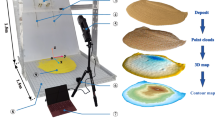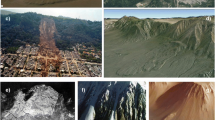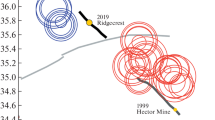Abstract
Large-scale gravitational spreading of steep-sided ridges characterized by linear fissures, trenches, and uphill-facing scarps high on the sides and tops of ridges are known worldwide. Such spreading, termed sackung, is commonly attributed to pervasive plastic deformation of a rock mass, and is here analyzed as such. Beginning with a previously developed exact elastic solution for gravity-induced stresses in a symmetric ridge, stresses calculated from the exact solution are used in the Coulomb failure criterion to determine the extent of ridge failure under self-weight. Finally, when the regions of failure are established, a plastic flow solution is applied to predict the location of and sense of movement on upward-facing scarps near ridge crests and other features common in sackung.
Résumé
Le phénomène d'affaissement par gravité des crêtes rocheuses à fortes pentes auxquelles sont associés des fissures linéaires, des tranchées et escarpements faisant face au sommet des crêtes est connu dans le monde entier. Cet affaissement, aussi connu sous le nom de «sackung», est communément atribué à un processus de déformation plastique du massif rocheux, et de ce fait, est analysé de cette façon. L'article commence par un rappel sur la solution élastique pour la distribution des contraintes induites par gravité dans une crête symétrique. Ensuite les contraintes calculées à l'aide de la solution élastique sont utilisées pour définir l'extension du domaine de rupture d'une crête rocheuse sous son propre poids avec l'hypothèse du critère de Coulomb. Finalement, après avoir défini les domaines de rupture, une solution d'écoulement plastique est utilisée pour prévoir la position et le sens de mouvement des escarpements faisant face au sommet des crêtes et prévoir d'autres caractéristiques communément associées au phénomène de «sackung».
Similar content being viewed by others
References
BECK, A. C. (1968): Gravity faulting as a mechanism of topographic adjustment: New Zealand Journ. Geology and Geophysics, v. 11, no. 1, p. 191–199.
BOVIS, M. J. (1982): Uphill-facing (antislope) scarps in the Coast Mountains, southwest British Columbia: Geol. Soc. America Bull., v. 93, no. 8, p. 804–812.
DRUCKER, D. C. and PRAGER, W. (1952): Soil mechanics and plastic analysis or limit design: Quarterly of Applied Mathematics, v. 10, no. 2, p. 157–165.
HOLMES, G. and JARVIS, J. (1985): Large-scale toppling within a sackung type deformation at Ben Atlow, Scotland: Quart. Journ. Eng. Geol., v. 18, p. 287–289.
KOBAYASHI, Kunio (1956): Periglacial morphology in Japan: Builetyn Periglacjalny Nr. 4, p. 15–36 (Lodzkie towarzystwo naukowe soietas scientarium lodziensis. Wydzial III, sectio III).
MUSKHELISHVILI, N. I. (1953), Some basic problems of the mathematical theory of elasticity: Noordhoof, Gronigen, The Netherlands, 718 p.
NEMČOK., Arnold (1972): Gravitational slope deformation in high mountains: Proc. 24th Internat. Geol. Cong., Montreal, Canada, sec. 13, p. 132–141.
NEMČOK, Arnold (1982). Zosuvy v Slovenskych Karpatoch, VEDA vydavatel'stvo Slovenskej akademie vied, Bratislava, 319 p.
NYE, J. F. (1951): The flow of glaciers and ice-sheets as a problem in plasticity: Royal Society [London] Proc., ser. A., v. 207, no. 1091, p. 554–572.
RADBRUCH-HALL, D. H., VARNES, D. J., and SAVAGE, W. Z. (1976): Gravitational spreading of steep-sided ridges (sackung) in western United States: Internation Association of Engineering Geology Bulletin, v. 14, p. 23–35.
RENGERS, N. and SOETERS, R. (1982): Two examples of gravitational spreading in the Bohi area, Spanish Pyrenees, International Training Center Journal, 1983(3), p 283–289.
SAVAGE, W. Z. and SMITH, W. K. [in preor], A model for the plastic flow of landslides: U,S. Geological Survey Professional Paper 1385.
SAVAGE, W. Z., SWOLFS, H. S., and POWERS, P. S. (1985): Gravitational stresses in long symmetric ridges and valleys: International Journal Rock Mechanics and Minerals Science, v. 22, No. 5, p. 291–302.
SHIMIZU, F., TOGO, M., and MATSUDA, T. (1980): Origin of scarplets around Mt. Noguchigoro-dake in the Japan Alps, central Japan: Geographical Review of Japan 53–58, p. 531–541.
SORRISO-VALVO, M. (1984): Atti del seminario “Deformazione gravitative profonde di versante”, Boll. Soc. Geol. It., v. 103, p. 667–669.
STINI, Josef (1941): Unsere Täler wachsen zu: Geologie und Bauwesen, Jahrg. 13, H. 3, p. 71–79.
STINI, Josef (1952): Neuer Ansichten über “Bodenbewegungen” über Beherrschung durch den Ingenieur: Geologie und Bauwesen, Jahrg. 19, H. 1, p. 31–54.
ZISCHINSKY, Ulf (1966): On the deformation of high slopes: International Society of Rock Mechanics, 1st Congress, Lisbon, Proceedings, v. 2, p. 179–185.
ZISCHINSKY, Ulf (1969): Uber Sackungen: Rock Mechanics, v. 1, p. 30–52.
Author information
Authors and Affiliations
Rights and permissions
About this article
Cite this article
Savage, W.Z., Varnes, D.J. Mechanics of gravitational spreading of steep-sided ridges («sackung»). Bulletin of the International Association of Engineering Geology 35, 31–36 (1987). https://doi.org/10.1007/BF02590474
Issue Date:
DOI: https://doi.org/10.1007/BF02590474




